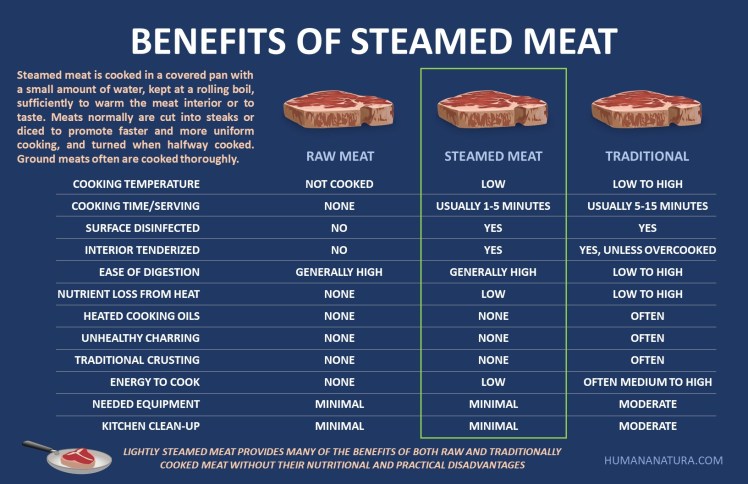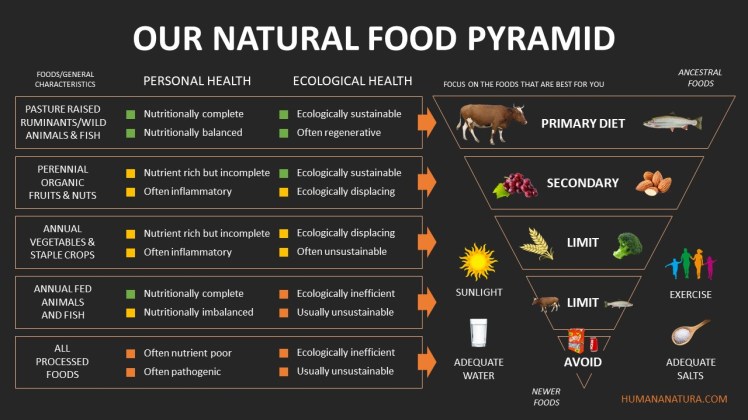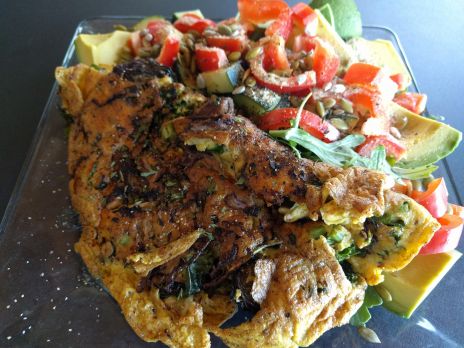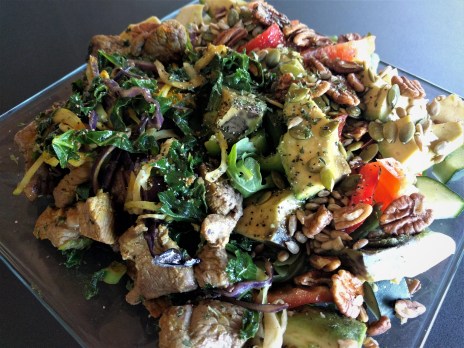Follow HumanaNatura On Facebook and Twitter
By Mark Lundegren

Living on meat and water. It may sound like punishment, akin to bread and water.
But what if I said that a diet exclusively or primarily of meat and water is the exact opposite? In this alternative, which you can easily explore and test yourself, meat and water are not a path of hardship or limitation. Instead, they are a means to new and more optimal natural fitness, flourishing, and even freedom – in our often denaturalized and over-complicated world, and as with modern minimalism or essentialism in general.
To help you understand why this opposite view may be the truth, I will summarize the case for a meat and water diet, and the simpler or more elemental lifestyle this commonly encourages. For this overview, I will approach the topic from six perspectives: nutrition, enjoyment, ecology, ethics, practice, and economics. And let me preface our discussion by saying that I have been living almost entirely on meat and water alone for several months now, after years of exploring many different forms of nutrition, and at the moment cannot imagine going back to any of these other ways of eating.
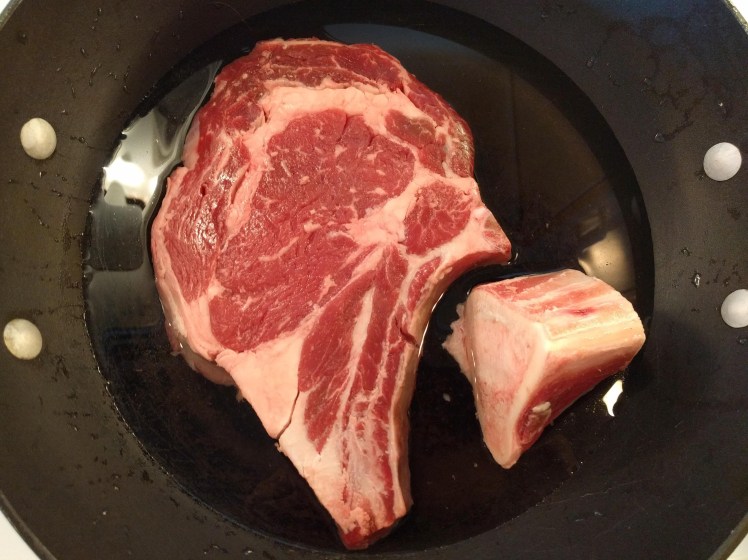
To clarify and also qualify our exploration of meat and water living, I want to define the term meat before continuing. Here, I will take it to mean the flesh of grass-fed and pasture-raised ruminant and similar vegetarian animals. And when I say flesh, I mean all parts of the animal. This includes protein and fat-rich muscle meats, and nutrient-dense organ meats and bone marrow. But for our discussion, since I primarily want to discuss an essentialist diet of meat and water, dairy products derived from these animals will not be counted as meat, even as many modern self-identified carnivores consume these foods.
Importantly, when ruminant animals – such as cattle, sheep, and buffalo – are pasture raised and thus fed a diet exclusively of grasses, legumes, and other cohabitating plants, this is not only natural in a historical sense, it also is a human system of agriculture that is both perennial or ongoing and polycultural or ecologically diverse. Because of this, it potentially is a fully sustainable form of agriculture as well.
After all, ruminant animals have lived abundantly on grasslands and in forests for tens of millions of years, before and since the rise of our species. And they did this sustainably, or in natural symbiosis or harmony with their environment, and notably in part because of health-promoting predation. In a similar way, wild fish harvesting and naturalized aquaculture also can be understood as natural and potentially sustainable, since this too is a perennial and polycultural food system, and fish harvested this way optionally may be included in my definition of meat. This is especially true when fish eat a natural diet, of course come from unpolluted waters, and are taken low in the marine food chain, since this is a naturally more efficient means of fish harvesting.
Following on this idea of the naturalness and common sustainability of perennial food systems, many other animal products, including ruminants raised unnaturally, can be understood as less desirable or optimal. In the case of omnivore animals, such as pigs and poultry (and bird eggs), this is partly because these food animals are often less nutritious for us than ruminant meat and wild fish overall. But more importantly, these animals normally must be fed human-cultivated grain and legume feeds to be raised at scale. The cultivation of these animals therefore is often indirectly damaging to the environment, in addition to being directly damaging when these animals are concentrated into small areas.
In contrast to perennial and polycultural ranching or fishing, human cultivation of grains and legumes for animal feeds is a system of agriculture that is not only inefficient, since we might eat these grains and legumes directly, but also one that is inherently annual and monocultural. Because of this, it is a form of agriculture not patterned on natural ecology and, unsurprisingly, one that is generally damaging to the environment and unsustainable in time (regardless of who or what eats the annual crops we grow). Let me add that the case against eating many carnivore animals is straightforward as well. Not only are their meats typically less nutritious and often unhealthfully lean as human foods, relative to ruminant meats and fish, but we again often might more simply, directly, and efficiently eat their food animals ourselves.
With this background, let’s consider a diet of meat and water from the six viewpoints I outlined:
> Nutrition – you may not be aware that there are people, including scientists and physicians, who recommend on health grounds not only a human diet that is principally carnivore, but one that is exclusively ruminant meat and water (with a bit of added salts to compensate for the typical lack of blood in modern meat-eating). Crucially, most advocate this approach to eating not as a study in the fact that we can do this, but that we should – if we are to fully optimize, renaturalize, and ancestralize our modern diets, nutrition, and health. Such so-called pure carnivore eating, like carnivory more generally, is of course controversial today, but it is also a way of eating that is almost wholly unstudied as well. And while the approach plainly goes against contemporary nutritional guidelines and social norms, pure carnivores routinely report marked satiety and reduced eating overall, vibrant or unprecedented health and well-being, superior physical fitness, and enhanced psychological calm and clarity, . In my own case, after following a fairly strict pure carnivore diet for several months, I appear to be at a level of general health and fitness unequalled before in my life and with the various nutritional regimes I have tried (including vegan, vegetarian, paleolithic, and omnivore ketogenic). In any case, a diet of grass-fed meat and water, including organ meats and adequate salts, instructively and perhaps tellingly is nutritionally complete, and contains all the essential nutrients that we require as human beings (including Vitamin C).
> Enjoyment – a common response to the idea that a meat and water diet is either natural, nutritionally complete, or optimally healthy for us, beyond disbelief, is the idea that the approach seems unbearably dull or monotonous, and leads us to miss out on the many foods and flavors that make eating enjoyable. While I hear this frequently from non-carnivores, notably I rarely hear it from carnivore eaters and have never heard it from a practicing pure carnivore. In my own experience, a meat and water diet is perfectly satisfying and highly satiating, meat is deliciously meat day after day, and I never long for other foods. Importantly, a meat and water diet naturally gives us abundant calories and nutrients in a small amount of food. As a result, we tend to eat less food and less often than non-carnivores – once or twice a day, with no snacking, is common. And in this way, the place of food and eating naturally becomes a less prominent and occupying part of our daily lives. Personally, I average about 30 minutes a day in shopping, cooking, eating, and cleanup, saving perhaps an hour per day compared to other diets, and I relish my newfound time and freedom from both hunger and needless eating. I should add that I also fast regularly and effortlessly, can go days without eating if need be, rarely plan my activities around my need to eat, and overall find this way of eating has opened me to more of life’s pleasures and opportunities. But I still enjoy and even relish my meals, and meat and water eating overall.
> Ecology – I’ve partly covered this topic in my definition of meat and overview of perennial agriculture, which again is a basic approach to food production that is entirely natural, generally ecologically aiding, often regenerative, and potentially fully sustainable. To recap, when ruminant animals are raised via perennial and polycultural agriculture – whether in pastures or forests – this system of agriculture substantially replicates the original natural environment of these animals. This is in contrast to the monocropping of annual plants, whether for human consumption or animal feeds, which comprises a large portion of modern farming and often a majority of the foods we typically eat. Unlike perennial food systems, monocropping is a system of agriculture without analog in nature, one that causes high soil disturbance and erosion, unnatural water runoff, and land aridification and desertification. Instead of this, perennial agricultural systems tend to: 1) increase water retention, 2) preserve and build native soils, 3) increase plant cover and photosynthesis, 4) reduce reflected sunlight and heat doming, 5) eliminate the need for fertilizers and pesticides, 6) reduce atmospheric carbon and ocean acidification, 7) aid species diversity, 8) promote natural weather patterns, and 9) increase hydrological cooling of the planet. Contrary to popular pronouncements, modern-day ruminants raised on healthy pasture and forest floors naturally sequester rather than release carbon, notably by building new soil, as they have for tens of millions of years. If you would like to explore these ideas, see Design for Planetary Health.
> Ethics – the ethics of meat-eating seem simple and clear-cut to some, often leading to ethics-based veganism today. But as we delve the topic, we quickly find subtlety and ambiguity. For brevity, I will focus on deaths of sentient animals from different forms of human agriculture. As such, I will overlook the mistreatment of animals, which appears categorically unethical and normally is illegal. I also will not consider various hardships inflicted on agricultural workers, which of course appears highest in the case of foods that must be laboriously harvested by hand. To consider relative animal death rates, I will make two instructive comparisons, understanding that others are possible. One comparison is perennial polycultural ranching versus monocrop annual farming, and the second perennial polycultural ranching versus natural or wild conditions. In perennial polycultural ranching, ruminant animals plainly are slaughtered for food, on the order of one animal per year for every two hectares (five acres) of land. In addition, these animals and their handlers are likely to step on or otherwise kill several thousands insects per hectare per year. However, other species, such as birds and small animals, normally are unaffected by perennial ranching, and even may benefit from the increased land fertility and biological diversity it can foster. By contrast, in the case of monocultural farming, the situation is almost completely reversed, good and bad. No livestock are slaughtered fro food, but there is massive displacement of native ecosystems from these agricultural activities, the common use of pesticides, and frequent necessity of other pest control measures. The result is death on the order of scores or hundreds of small animals and birds per hectare per year, along with millions of flying and burrowing insects. Perhaps unintuitively at first, the case of land left natural or wild returns us to conditions quite similar to perennial ranching, since this form of agriculture is so natural. In wild conditions, both larger and smaller animals are subject to natural predation and death, and all animal birth and death rates naturally equalize in time as niches are filled. In addition, these ecosystems often naturally lose biological activity and robustness when top predators are removed or over-hunted. With these ideas in mind, you can see that ruminant meat-eating is ethically on par with wild conditions, and may be morally superior to diets making extensive use of annual monocropping.
> Practice – my photo above may have led you to suspect that meat and water nutrition isn’t only a description of the foods we might eat, but also of how we can cook meat too. In practice, lightly boiling and steaming meat in water offers a number of advantages over other forms of cooking, and also over the practice of eating meat raw, as some carnivores do. Notably, the approach: 1) cooks at a relatively low temperature, 2) minimizes nutrient and fat loss, allowing comparable nutrition with less food, 3) at once disinfects and tenderizes meat, 4) in no way impairs the taste of meat (it even improves the flavor of some meats, such as liver), 5) uses minimal energy and equipment, and 6) requires modest clean-up after cooking and keeps kitchens clean far longer overall. If you haven’t tried water-cooked meat, you should, since it arguably is the best way to prepare meats of all kinds. Depending on the size and type of meat, and how deeply you want the meat cooked, the practice of cooking meat in water takes minutes and is almost foolproof. For a 0.5 kilogram (16 ounce) steak, butchered roast, or marrow bone, 90-150 seconds of simmering/steaming per side – in a covered pan with about a half centimeter (quarter inch) of water – will leave the meat very rare, moist, warm throughout, minimally degraded, very easy to eat and digest, and delicious (it will taste like meat). Thin slices of liver, by contrast, normally are cooked in 30 seconds or less on each side. When cooking this way, I usually bring water to a boil in my cooking pan first, add the meat, cover and set my timer, repeat on the other side when ready, and serve the meat or marrow bone immediately and lightly salted. As I said, cooking meat with water is easy and you will quickly learn to cook this way for optimal taste, nutrition, and practicality. And on the topic of water, I drink whenever I am thirsty, and this usually works out to about two liters (65 fluid ounces) per day.
> Economics – I have described the simplicity of cooking meat with water, our typical need to eat only once or twice a day on a meat and water diet. and the unprecedented fitness, vitality, calm, and sense of personal freedom or autonomy that many people report when eating only meat and water. Add to this food costs that are comparable to other forms of health-conscious eating (the meal in the photo cost $10 and was all I ate that day), and our discussion should suggest there may be new economic benefit or freedom waiting in meat and water eating as well. This is a very personal topic, but consider the small size and simplicity of the kitchen you would need to lightly boil meat for yourself and your family, once or twice a day. No elaborate equipment, no oven, perhaps only a small refrigerator, sink, single or double-burner stove, and a pan or two. And with this lesson – and especially feeling strong, naturally complete, and at your best from this essentialized way of eating – consider how many other rooms, and things in them, you might need to live richly and happily. Again, this is quite personal. But the daily lesson of simplicity, essentiality, and freedom that comes from not just surviving but thriving on a diet of meat and water is powerful. You would not be the first person to take this lesson out of their meals and across the totality of their lives.
Whether you are a practicing carnivore today or not, I hope I have inspired and equipped you to experiment with this at once new, old, reliably revitalizing, and profoundly simple way of eating, and then living. The only thing I would add is that the transition to meat and water living is a transition. It is easier if you are generally healthy, and begin from a healthy and especially ketogenic diet. But expect new learning, adjustment, and the need for a bit of persistence at first, and in all cases.
Based on my experience and learning from others following a meat and water diet, it is usually a month of change and challenge, but also of increasing understanding and vitality too. Then, for many, the way is clear to a new, more natural, and more vital personal state of modern health, fitness, ecology, clarity, and life.
Mark Lundegren is the founder of HumanaNatura.
Tell others about HumanaNatura…encourage modern natural life & health!




